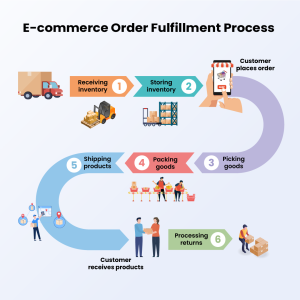The journey from clicking a “buy now” button to receiving a package is more complex than it seems. Ecommerce fulfillment is the invisible engine that powers this process, turning digital transactions into tangible experiences. It involves far more than storing and shipping products, weaving together technology, strategy, and precision. Without it, even the most innovative online store would crumble under the weight of customer expectations.

As online shopping continues to expand, Ideal Fulfillment has become a battlefield for competitive advantage. Businesses that once viewed it as a simple logistical task now see it as a strategic necessity. A seamless fulfillment process builds trust, strengthens brand loyalty, and drives repeat purchases. It transforms customer satisfaction from a marketing slogan into a measurable reality.
Modern ecommerce fulfillment starts long before a package leaves a warehouse. It begins with accurate inventory management, where real-time data ensures that stock levels match consumer demand. Predictive analytics and automation are increasingly used to anticipate orders before they happen. This proactive approach reduces stockouts, eliminates overstock, and improves cash flow efficiency.
But inventory is only one piece of the puzzle. Storage optimization is another crucial factor, where the layout and organization of products influence the speed of order processing. Advanced storage solutions use algorithms to determine the best product placement based on order frequency. Faster retrieval means faster packing, and ultimately, quicker deliveries. These micro-optimizations can significantly enhance the overall customer experience.
Order processing itself has evolved into a highly automated, technology-driven operation. Systems now automatically route orders to the nearest fulfillment center, minimizing delivery times and reducing shipping costs. Packing is no longer just about placing items in a box; it’s about balancing protection, weight, and sustainability. Smart packaging technologies are even being used to monitor temperature, track location, and verify product authenticity during transit.
Shipping, once considered the final step, has become an extension of the fulfillment experience. Today’s consumers expect transparency, flexibility, and speed. Real-time tracking and predictive delivery notifications have shifted from perks to expectations. Some fulfillment models even allow customers to modify delivery options mid-transit, adding another layer of personalization.
Reverse logistics, or the handling of returns, is another often-overlooked aspect of ecommerce fulfillment. A poorly managed returns process can erode trust and deter future purchases. Efficient systems not only process returns quickly but also reintegrate returned products into inventory with minimal delay. This closed-loop approach reduces waste and improves operational efficiency.
Sustainability has emerged as a critical dimension in fulfillment strategies. Consumers are increasingly aware of the environmental impact of their purchases, and they expect brands to share that responsibility. Fulfillment operations now experiment with eco-friendly packaging, carbon-neutral shipping options, and energy-efficient storage solutions. These practices are not just ethical choices but strategic ones that resonate with modern buyers.
Another trend reshaping fulfillment is the rise of decentralized warehousing. Instead of relying on massive central facilities, many businesses are shifting to smaller, strategically located centers closer to customers. This model reduces delivery times, lowers transportation costs, and enhances scalability. It also enables businesses to offer same-day or next-day delivery options that were once considered premium services.
Artificial intelligence and machine learning are transforming how fulfillment networks operate. Algorithms analyze historical data to predict demand surges, optimize routes, and even suggest changes in packaging. Predictive fulfillment, where products are shipped before an order is placed based on behavioral data, is already becoming a reality. Such innovations blur the line between logistics and personalization, setting a new standard for customer satisfaction.
Robotics is another frontier in fulfillment innovation. Autonomous robots navigate warehouses, retrieve products, and assist with packing, significantly reducing processing time. These machines work alongside human teams, handling repetitive tasks while freeing workers to focus on quality control and customer service. As robotic technology becomes more advanced, the speed and accuracy of fulfillment will only continue to improve.
Fulfillment is also expanding beyond physical products. With the rise of subscription models and digital marketplaces, businesses are reimagining how recurring shipments and curated boxes are prepared and delivered. Predictable schedules, personalized selections, and seamless integration with subscription platforms are redefining the fulfillment landscape. Each of these innovations deepens the relationship between customer and brand.
Customer expectations are evolving, and fulfillment must evolve with them. The “fast and free” delivery model has set a high standard, but now customers also demand transparency, flexibility, and sustainability. Businesses that fail to meet these expectations risk losing loyalty, even if their products are exceptional. Fulfillment is no longer a behind-the-scenes function—it’s a core part of the customer journey.
The future of ecommerce fulfillment will likely focus on hyper-personalization and predictive delivery. Imagine a system where purchases arrive almost before they are made, anticipated by data patterns and lifestyle signals. Such advancements will require a fusion of logistics, artificial intelligence, and behavioral science. Yet, they promise to deliver unparalleled convenience and deepen consumer trust.
Another emerging dimension is the integration of fulfillment with social commerce and omnichannel retail. As shopping experiences blend across platforms, fulfillment systems must synchronize with multiple sales channels simultaneously. This requires unified inventory systems, real-time data sharing, and flexible logistics that adapt to fluctuating demand. The businesses that master this integration will define the next era of ecommerce.
Data will continue to be the lifeblood of fulfillment strategies. From tracking product movement to analyzing customer preferences, data enables smarter decisions at every step. It can predict demand patterns, optimize storage space, and even identify inefficiencies in packaging or delivery routes. The ability to turn this data into actionable insights will separate industry leaders from laggards.
Fulfillment is also becoming a powerful storytelling tool. How a product arrives—its packaging, timing, and presentation—conveys a message about the brand’s values and commitment. Companies are experimenting with branded unboxing experiences, personalized messages, and eco-conscious materials to create emotional connections. These details transform fulfillment from a transactional process into a memorable part of the customer journey.
In a hyper-competitive digital marketplace, fulfillment is no longer just about logistics—it’s about strategy, innovation, and differentiation. It shapes customer perceptions, drives loyalty, and fuels growth. It determines whether a purchase becomes a one-time event or the beginning of a long-term relationship. And it is the bridge between digital promise and physical reality.
The evolution of ecommerce fulfillment reflects the broader transformation of commerce itself. What was once a back-office function is now a central pillar of competitive strategy. As technology continues to advance and customer expectations rise, fulfillment will remain at the forefront of innovation. It is the hidden backbone of online commerce—quiet, powerful, and indispensable.
Looking ahead, the businesses that thrive will be those that view fulfillment not as a cost center but as a catalyst for growth. They will invest in technologies that anticipate needs, processes that delight customers, and strategies that align logistics with brand values. In doing so, they will turn fulfillment from a behind-the-scenes necessity into a defining advantage. The future of ecommerce will belong to those who master this silent yet transformative force.



